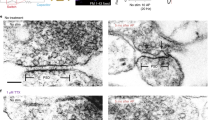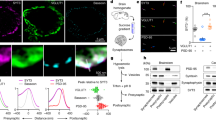Abstract
WHEN an action potential reaches a synaptic terminal, fusion of a transmitter-containing vesicle with the presynaptic membrane occurs with a probability (pr) of less than one1. Despite the fundamental importance of this parameter, pr has not been directly measured in the central nervous system. Here we describe a novel approach to determine pr monitoring the decrement of NMDA (N-methyl-D-aspartate)-receptor mediated synaptic currents in the presence of the use-dependent channel blocker MK-801 (ref. 2). On a single postsynaptic CA1 hippocampal slice neuron, two classes of synapses with a sixfold difference in pr are resolved. Synapses with low pr contribute to over half of transmission and are more sensitive to drugs enhancing transmitter release. Switching between these two classes of synapses provides the potential for large changes in synaptic efficacy and could underlie forms of activity-dependent plasticity.
This is a preview of subscription content, access via your institution
Access options
Subscribe to this journal
Receive 51 print issues and online access
$199.00 per year
only $3.90 per issue
Buy this article
- Purchase on Springer Link
- Instant access to full article PDF
Prices may be subject to local taxes which are calculated during checkout
Similar content being viewed by others
References
Katz, B. The Release of Neural Transmitter Substances (Thomas, Springfield, Illinois, 1969).
Huettner, J. E. & Bean, B. P. Proc. natn. Acad. Sci. U.S.A. 85, 1307–1311 (1988).
Jahr, C. E. Science 255, 470–472 (1992).
Hestrin, S., Sah, P. & Nicoll, R. A. Neuron 5, 247–253 (1990).
Strichartz, G. J. gen. Physiol. 62, 37–57 (1973).
Edmonds, B. & Colquhoun, D. Proc. R. Soc. B250, 279–286 (1992).
Lester, R. A. J. & Jahr, C. E. J. Neurosci. 12, 635–643 (1992).
Clements, J. D., Lester, R. A. J., Tong, G., Jahr, C. E. & Westbrook, G. L. Science 258, 1498–1501 (1992).
Rahamimoff, R. J. Physiol., Lond. 195, 471–480 (1968).
Jack, J. J. B., Redman, S. J. & Wong, K. J. Physiol., Lond. 321, 111–126 (1981).
Lin, J-W. & Faber, D. S. J. Neurosci. 8, 1313–1325 (1988).
Liao, D., Jones, A. & Malinow, R. Neuron 9, 1089–1097 (1992).
Lester, R. A. J., Clements, J. D., Westbrook, G. L. & Jahr, C. E. Nature 346, 565 (1990).
Clements, J. D. & Westbrook, G. L. Neuron 7, 605–613 (1991).
Rosenmund, C., Clements, J. D. & Westbrook, G. L. Biophys. Soc. Abstr. A327 (1993).
Atwood, H. L. Nature 215, 57–58 (1967).
Redman, S. & Walmsley, B. J. Physiol. Lond. 343, 135–145 (1983).
Walmsley, B., Edwards, F. R. & Tracey, D. J. J. Neurophys. 60, 889–908 (1988).
Clamann, H. P., Mathis, J. & Luscher, H.-R. J. Neurophys. 61, 403–416 (1989).
Rosenmund, C., Clements, J. D. & Westbrook, G. L. Science 262, 754–757 (1993).
Author information
Authors and Affiliations
Rights and permissions
About this article
Cite this article
Hessler, N., Shirke, A. & Malinow, R. The probability of transmitter release at a mammalian central synapse. Nature 366, 569–572 (1993). https://doi.org/10.1038/366569a0
Received:
Accepted:
Issue Date:
DOI: https://doi.org/10.1038/366569a0
This article is cited by
-
Asynchronous release sites align with NMDA receptors in mouse hippocampal synapses
Nature Communications (2021)
-
Aberrant activity of mitochondrial NCLX is linked to impaired synaptic transmission and is associated with mental retardation
Communications Biology (2021)
-
The glutamatergic synapse: a complex machinery for information processing
Cognitive Neurodynamics (2021)
-
Encoding of contextual fear memory in hippocampal–amygdala circuit
Nature Communications (2020)
-
Synaptic vesicles transiently dock to refill release sites
Nature Neuroscience (2020)
Comments
By submitting a comment you agree to abide by our Terms and Community Guidelines. If you find something abusive or that does not comply with our terms or guidelines please flag it as inappropriate.



